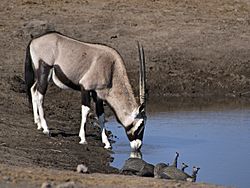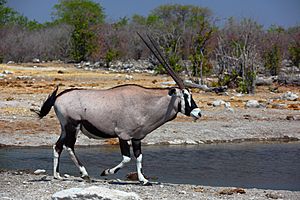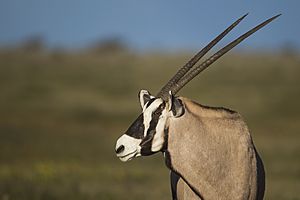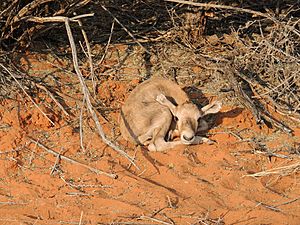Gemsbok facts for kids
Quick facts for kids Gemsbok |
|
|---|---|
 |
|
| Scientific classification | |
| Kingdom: | |
| Phylum: | |
| Class: | |
| Order: | |
| Family: | |
| Subfamily: |
Hippotraginae
|
| Genus: | |
| Species: |
O. gazella
|
| Binomial name | |
| Oryx gazella |
|
The gemsbok or gemsbuck (Oryx gazella) is a large antelope that lives in the plains of Africa. You can find them in many parts of Africa, especially in countries like Tanzania, Namibia, and South Africa.
Contents
About Gemsboks
Gemsboks are usually light brownish-grey or tan. They have lighter patches near their rear. Their tails are long and black. A black stripe runs from their chin, down their neck, and along their sides to their back legs.
They have strong necks and shoulders. Their legs look like they have white 'socks' with a black patch on the front of their front legs. Both male and female gemsboks have long, straight horns.
Gemsboks are the biggest type of Oryx. They stand about 1.2 m (3.9 ft) tall at the shoulder. Their bodies can be from 190 to 240 cm (75 to 94 in) long. Their tails measure 45 to 90 cm (18 to 35 in). Male gemsboks can weigh between 180 and 240 kg (400 and 530 lb). Females weigh a bit less, from 100–210 kg (220–460 lb).
Gemsbok Horns
Gemsboks are known for their amazing horns. These horns are usually about 85 cm (33 in) long. It can be hard to tell males and females apart just by looking at their horns from far away.
Male gemsboks usually have thicker horns with wider bases. Female gemsboks tend to have horns that are a bit longer and thinner.
Female gemsboks use their horns to protect themselves and their young from animals that might try to hunt them. Male gemsboks mainly use their horns to defend their own areas from other males.
How Gemsboks Live
Gemsboks live in groups called herds. A herd usually has about 10 to 40 animals. These herds include one main male, a few other males, and several females. They mostly live in desert areas. They are very good at living in dry places and do not need to drink water often. They can run very fast, up to 60 km/h (37 mph).
What Gemsboks Eat
Gemsboks usually eat grass. But when the weather is dry or there isn't much grass, they will eat other plants. They can dig up to a meter deep to find roots and tubers. They also get water by eating wild tsama melons and cucumbers. These plants can give them all the water they need.
Reproduction

One male gemsbok will mate with the females in his herd. He tries to keep the females in his territory so he can be the only one to mate with them. Gemsboks do not have a specific time of year for breeding. However, the young in a herd are often born around the same time.
Pregnant females leave the herd before they give birth. The baby gemsbok stays inside its mother for about 270 days. Mothers usually give birth to one or two calves. The calf stays hidden for about six weeks after it is born. After that, the mother and calf rejoin the herd. The calf stops drinking milk at about 3.5 months old. It becomes independent at 4.5 months. Both male and female gemsboks can have their own babies when they are about 1.5 to 2 years old.
Gemsboks in North America
In 1969, the New Mexico State Department of Game and Fish brought gemsboks to the Tularosa Basin in the United States. This was done to find a balance between protecting nature and using it for other purposes. Ninety-three gemsboks were released between 1969 and 1977. Today, there are about 3,000 gemsboks there. They have done very well because their natural predators, like the lion, are not found in that area.
Images for kids
-
Buck on the Jornada del Muerto trail north of Upham, New Mexico, USA
See also
 In Spanish: Órice del Cabo para niños
In Spanish: Órice del Cabo para niños






